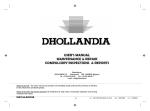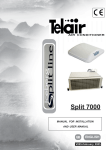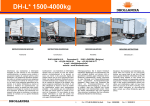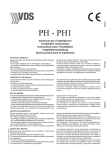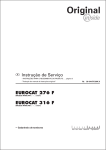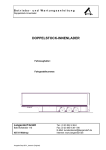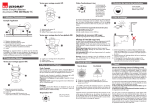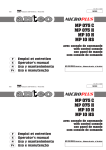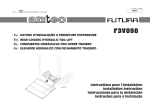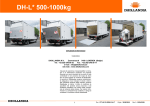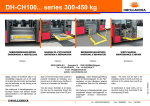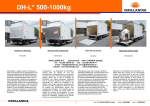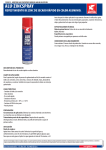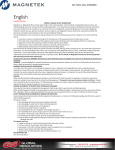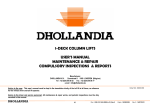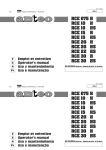Download DH-V* 500-2000 kg
Transcript
DH-V* 500-2000 kg MONTAGE INSTRUCTIES INSTRUCTIONS DE MONTAGE MONTAGE ANLEITUNG MOUNTING INSTRUCTIONS Fabrikant : Constructeur : Hersteller : Manufacturer : DHOLLANDIA N.V. Zoomstraat 9 9160 LOKEREN (Belgium) Tel : +32 (0)9 349 06 92 Fax : +32 (0)9 349 09 77 e-mail : [email protected] website : www.dhollandia.com Disclaimer: de afbeeldingen en gegevens in deze handleiding zijn niet contractueel bindend en kunnen geen grond vormen voor enige juridische vordering tegen DHOLLANDIA. DHOLLANDIA laadkleppen worden continu aangepast aan nieuwe ontwikkelingen op gebied van voertuigen en voertuigchassis, en aan de noden van haar klanten. Daarom behoudt DHOLLANDIA zich het recht voor om productspecificaties te wijzigen zonder voorafgaande melding, waardoor het mogelijk is dat deze wijzigingen niet opgenomen zijn in deze druk. Indien u verdere informatie wenst over gewijzigde onderdelen, gelieve uw officiële DHOLLANDIA-agent te contacteren voor advies. DHOLLANDIA Avertissement : Les illustrations et informations reprises dans ce manuel ne sont pas contraignantes contractuellement et ne peuvent en aucun cas mener à des poursuites légales de quelque nature que ce soit à l’encontre de Dhollandia. Les hayons élévateurs Dhollandia sont en constante évolution pour s’adapter aux nouveautés en matière de véhicules et de châssis, ainsi qu’aux exigences spécifiques des clients. À cet effet, Dhollandia se réserve le droit de modifier les spécifications produit sans avertissement préalable ; il est possible que ces modifications ne soient pas encore prises en compte au moment de l’impression. Si vous désirez de plus amples informations au sujet des parties non conformes, n’hésitez pas à prendre contact avec votre agent Dhollandia agréé. Haftungsausschluss: Die in diesem Handbuch enthaltenen Abbildungen und Informationen sind nicht vertraglich bindend, und können nicht zu gerichtlichen Schritten gegen Dhollandia führen. Dhollandia Hubladebühnen werden permanent an neue Fahrzeug- und Chassis-Entwicklungen sowie spezialisierte Kundenanforderungen angepasst. Daher behält sich Dhollandia das Recht vor, Produktspezifikationen ohne vorhergehende Benachrichtigung zu ändern. Es ist möglich, dass zum Zeitpunkt des Drucks Änderungen nicht berücksichtigt wurden. Wenn Sie weitere Informationen über nicht konforme Teile wünschen, kontaktieren Sie Ihren offiziellen Dhollandia-Händler für eine Beratung 1 Doc : FIT-V01-2009-01A_Rev0 Disclaimer: the illustrations and information contained within this manual are not contractually binding, and cannot lead to any form of legal action against Dhollandia. Dhollandia tail lifts are constantly being adapted to new vehicle and chassis developments, and specialised customer requirements. Therefore Dhollandia reserves the right to alter product specifications without prior notice; and modifications might not have been taken into account at the time of printing. If you require further information on non-conforming parts, contact your official Dhollandia agent for advice. Origin : 30/06/2008 Rev. 0 : 12/01/2010 DE EN Inhaltsverzeichnis Contents 0) LISTE DER ABKÜRZUNGEN ................................................................................. 4 0) LIST OF ABBREVIATIONS ..................................................................................... 5 1) ALLGEMEINE MONTAGEANLEITUNGEN ............................................................. 6 1) GENERAL FITTING INSTRUCTIONS ..................................................................... 7 2) VARIANTEN VON HLB-HUBWERKEN UND MONTAGEMETHODEN .................. 12 2) TYPES OF HTL FRAMES AND FITTING METHODS ............................................. 13 3) VORBEREITUNG DER ARBEIT AN FAHRZEUGKAROSSERIE 3) PREPARATION WORK ON VEHICLE BODY, CHASSIS ....................................... 15 UND -CHASSIS ...................................................................................................... 14 4) MOUNTING OF THE LIFT FRAME: 3 WAYS TO GET STARTED .......................... 23 4) MONTAGE DES HUBWERKS: 3 METHODEN ZUM BEGINNEN .......................... 22 §4.1 - Method with the fitting jigs ........................................................................ 23 §4.1 - Methode mit den Montageschablonen..................................................... 22 §4.2 - Method with vertical platform ................................................................... 25 §4.2 - Methode mit vertikaler Plattform ............................................................. 24 §4.3 - Auswirkungen der Gummi-Plattformdichtungen (Option S600, 601...) .... 28 §4.3 - Impact of rubber platform seals (option S600, 601...) ............................... 29 §4.4 - Methode mit horizontaler Plattform .......................................................... 28 §4.4 - Method with horizontal platform ................................................................ 27 5) MONTAGE DES HUBWERKS UNTER DEM CHASSIS ......................................... 32 5) MOUNTING OF THE LIFT FRAME UNDER THE CHASSIS................................... 33 §5.1 - Testmontage Hubwerk und Montageplatten ............................................ 32 §5.1 - Test fitting lift frame and mounting plates ................................................. 33 §5.2 - Fixierung der geschraubten Montageplatten am Fahrzeugchassis ......... 34 §5.2 - Fixation of the bolt-on mounting plates to the vehicle chassis .................. 35 §5.3 - Montage der verschweißten Montageplatten am Fahrzeugchassis ......... 40 §5.3 - Fixation of the integrated mounting plates to the vehicle chassis ............. 41 §5.4 - Allgemeine Hinweise ............................................................................... 40 §5.4 - General remarks ....................................................................................... 41 6) MONTAGE DER PLATTFORM & FERTIGSTELLUNG DER 6) MOUNTING THE PLATFORM & FINALIZING THE MECHANICAL WORK ............ 43 MECHANISCHEN ARBEITEN ................................................................................ 42 §6.1 - Mounting the platform to the lift arms ....................................................... 43 §6.1 - Montage der Plattform an die Hubarme................................................... 42 §6.2 - Montage der Plattformschläge für die Betriebsposition ........................... 46 §6.2 - Mount the end stops for the work position ................................................ 47 §6.3 - Einstellung der Fahrtposition der Plattform.............................................. 48 §6.3 - Finalize the stow position of the platform .................................................. 49 §6.4 - Montage des Unterfahrschutzes .............................................................. 52 §6.4 - Mounting of the bumper bar ...................................................................... 53 7) ELEKTRISCHER ANSCHLUSS DER HLB ............................................................. 54 7) ELECTRICAL INSTALLATION OF THE HTL .......................................................... 55 §7.1 - Montage der Bedienung, des (+) Batteriekabels §7.1 - Mounting of the control box, the (+) battery cable and (-) earth cable ...... 55 und (-) des Massekabels ......................................................................... 54 §7.2 - Optional mounting brackets for the external control box ........................... 55 §7.2 - Optionale Montagebügel für die externe Bedienung ............................... 54 8) PUTTING THE HTL INTO SERVICE ....................................................................... 57 8) INBETRIEBNAHME DER HUBLADEBÜHNE ......................................................... 56 ANNEXES ..................................................................................................................... 61 ANHÄNGE .................................................................................................................... 60 A.1 - Maximum tightening torques for bolts in N.m ....................................................... 61 A.1 - Vorgeschriebene Anzugsdrehmomente für Schrauben in N.m ............................ 60 A.2 - Übersicht der wichtigsten HLB Komponenten ...................................................... 62 A.2 - Overview of the principal HTL components .......................................................... 63 A.3 - Schmierplanen ..................................................................................................... 64 A.3 - Electric and hydraulic diagrams ............................................................................ 65 A.4 - Elektrische und hydraulische Schaltpläne ............................................................ 66 A.4 - Electric and hydraulic diagrams ............................................................................ 67 DHOLLANDIA 3 EN 0) LIST OF ABBREVIATIONS Attention! Or: Danger! Don’t do! Consult the text which is referred to M Applicable to HTL with mechanical tilt at ground level (DH-LM, LC, LMP,…) H Applicable to HTL with hydraulic tilt at ground level (DH-LSU, LSP*, LV, LE,…) Tag indication something is “correct” Tag indication something is “incorrect” Study in detail EX. Example, not for all models identical! Drawing attention to a particular item in a drawing or illustration ! 1 2 Numbered references between text & illustration, or between 2 illustrations To be executed symmetrically on both sides Bolt instructions Drill instructions Apply sufficient anti-corrosive protection (zincspray, Dinitrol, …) Grease thoroughly all articulation bearings and pins HTL Hydraulic tail lift DHOLLANDIA 5 EN 1.1 EX. 1) GENERAL FITTING INSTRUCTIONS Before the preparation of the vehicle chassis and installation of the Hydraulic Tail Lift (= named HTL hereafter), read and make sure you understand the underlying fitting instructions first, and progress step by step after that. Before getting started, also take notice of the safety instructions for repair and maintenance, included in the user’s manual issued with this HTL. In case of doubt, and before making any further progress, please consult your Dhollandia-agent. After installation, perform the put-into-service test following the check-list included in the user’s manual, and fill-out the CE Fitting Declaration in the same document. Check the following points before getting started: • Check if the kit is complete, and if all parts needed to fit the HTL correctly have been delivered. • Compare the voltage of the batteries of the vehicle with the voltage of the hydraulic power pack of the HTL. • Compare the fitting dimensions given on the “FITTING DRAWING” [see Fig. 1.1] with the actual dimensions of the vehicle concerned . The actual floor height K should not exceed the theoretical maximum lifting height of the HTL, which depends on its arm-length. 1.2 • Observe the FITTING AND BODY BUILDING INSTRUCTIONS of the manufacturer of the vehicle. Observe in particular the maximum allowed HTL capacity, the instructions on the use of hydraulic stabilising legs, the instructions for mounting and bolting to the vehicle chassis, and the manufacturer’s guidelines for the electrical interfaces [See Fig. 1.2]. DHOLLANDIA 7 EN • Check if the structure of vehicle chassis and body are strong enough to carry the proper weight of the HTL with its nominal load, and to resist the forces & moments induced by the platform and its load. Check the stability of the vehicle and the weight on the vehicle axles in function of the real proper weight of the HTL, and the load which is expected to be handled. The weights indicated in the technical documentation and price list are theoretical, and may vary according to the specific execution of the HTL. • Make sure that the body is accurately fitted to the vehicle chassis. Place the vehicle on a even flat ground. • Always remove the battery clips and ABS plugs during fitting. • Finish the HTL in accordance with the road legislation of the country where the vehicle will be registered. • Welding should be done by qualified personnel only, and only to the extent that such is not forbidden by the manufacturer of the vehicle. • When connecting hydraulic parts, make sure that the connections are totally clean, and that the hydraulic circuit doesn’t get contaminated. • Grease all bearings and pins before putting the HTL into service. It is recommended to grease all articulation bearings before mounting the corresponding articulation pin. • Do not overpressure any lift functions (lift / close / retract in or out) before full completion of the installation. • During fitting and testing, make sure that the HTL and its moving parts don’t interfere with, or cause damage to the vehicle suspension, braking system, oil pipes and wiring circuits. • Any modifications to the mounting plates and fitting procedures are strictly forbidden. No deviation is allowed without prior written approval from DHOLLANDIA. DHOLLANDIA 9 EN • These fitting instructions aim to clarify and teach the work method required to fit DHOLLANDIA HTL successfully. On numerous occasions, reference will be made to the TECHNICAL SUMMARY of the various lift types. These TECHNICAL SUMMARIES contain quantified details for each individual lift type. Some illustrations in these fitting instructions therefore mention that they are an example, which means that they don’t apply to each and every lift model covered by this handbook. • The various steps of these fitting instructions are characterised by a LETTER reference above each chapter. This to help those fitting companies that wish to split-up the work between the different skills or specialties within the labour force. G = General guide lines E = Electrical work M = Mechanical work / steel plating work F = Finish & anti-corrosive protection S = Test and put into Service • See Annex A.2 for an overview of the principal HTL components. DHOLLANDIA 11 EN G 2.1 2.2 EX. 2) PREPARATION WORK ON VEHICLE BODY, CHASSIS • Refer to the FITTING DRAWING or the product-specific TECHNICAL SUMMARY to get insight in the most important technical fitting parameters, and to determine the scope of the work that will be required to prepare and adapt the vehicle chassis to the HTL. • Both documents contain useful fitting information such as: 1. Column & platform dimensions 2. Max. lifting height in function of the HTL dimensions 3. Depth of the HTL behind the vehicle body 4. … • But: → FITTING DRAWING = 1 single page, with fitting details of 1 specific HTL on 1 well-defined vehicle = study on request or order confirmation. [See Fig. 2.1] → TECHNICAL SUMMARY = general fitting information for a type of HTL, separated from a specific vehicle. See www.dhollandia.com or local DHOLLANDIA agent. [See Fig. 2.2] • These fitting instructions assume that the rear frame of the vehicle body is sufficiently strong to carry the HTL and its load, and the dynamic forces from working with it, over the expected lifetime of the HTL. DHOLLANDIA disclaims liability for any personal injury or property damage that results from mounting the HTL to a vehicle body that is too weak for purpose. • Check that the main dimensions of the supplied HTL conform to the dimensions of your order. DHOLLANDIA 13 EX. EN G 2.3 EX. 2.4 EX. • Ensure that the rear frame of the vehicle body is flush and free from any obstructions. Remove all obstructions, or create a flush mounting surface by using suitable packers. • Make sure that the vehicle licence number plate, rear lights, etc... will not conflict in any way with the cylinder beam or the bumper bar when the HTL is in it’s installed position. • For vehicles with rear doors, make sure to confirm your drawing of internal hinges [see Fig. 2.3] or external hinges [see Fig. 2.4] at the stage of ordering, as it will influence on the configuration of the HTL supplied. E • Remove the battery clips from the batteries, If the vehicle is equipped with an ABS system, or other electronic devices, loosen the corresponding plugs in the vehicle cabin. DHOLLANDIA 15 EN G M 3.1 3.2 3) MOUNTING OF THE HTL FRAME • The frames of the column HTL can be mounted to the rear frame of the vehicle body in 2 different ways: 1. WELD-ON fitting: the columns and cylinder beam are welded to the mounting frame of the vehicle body. 2. BOLT-ON fitting: the columns and cylinder beam are bolted to the mounting frame of the vehicle body. • Take this information into account when preparing the fitting work of the HTL. §3.1 - WELD-ON fitting • Use a fork lift, overhead gantry crane or other safe lifting equipment to raise the HTL, and approach it to the rear frame of the vehicle body. [See Fig. 3.1] • Push the HTL frame firmly against the rear frame of the vehicle body, and raise / lower it to the correct fitting height. 3.3 • For HTL with an integrated floor extension, this is the height whereby the top side of the floor extension or cylinder beam is flush with the vehicle loading floor. For other lifts, source the correct height from the FITTING DRAWING. • Check that the ground clearance is as per FITTING DRAWING. Take note of the bumper height. The clearance from the ground to the under side of bumper should not exceed 550mm. [See Fig. 3.2] • Centre the HTL frame, align it, and make sure it is square to the vehicle body and loading floor. [See Fig. 3.2] DHOLLANDIA 17 EN G M 3.3 3.4 • Disconnect the battery terminals prior to welding. Welding [DH-VB4] should be done by qualified personnel only, and only to the extent that such is not forbidden by the manufacturer of the vehicle. • Clamp the columns to the rear frame of the vehicle, and tag weld them at the top, sufficiently strongly to prevent the HTL from falling when trying out the different platform positions. [See Fig. 3.3] • Check the column centres at the top, middle and bottom of the columns. Adjust the alignment if required. [See Fig. 3.2] • If disconnected, reconnect the power pack to the HTL. Connect the power pack to an external battery. • LOWER and OPEN the platform into work position. Prior to finishing the big welding work, test the platform in all positions. LOWER the platform and test if it reaches ground level (at the expected position of the vehicle suspension). LIFT the platform and test if it reaches the expected lifting height. 3.5 EX. [DH-VB4] [DH-VOC] • If all OK, weld the columns to the rear frame of the vehicle according to the welding instructions. [See Fig. 3.4]. ! • Ensure that no grinding swarf, welding spatters, other dirt... drop down into the columns. Failure to prevent this may cause excessive wear to the columns, lift runners and their Teflon wear pads or roller bearings [see Fig. 3.5], or might cause irreparable damage to the chains or steel cables. ! ! • DON’T weld close to the Teflon wear pads mounted on the lift runners. LIFT / LOWER the platform in order to keep the Teflon wear pads or roller bearings at max. distance from the location where you weld. DON’T subject the chains or steel cables to heat. ! ! DHOLLANDIA EX. 19 EN G M 3.7 3.6 EX. §3.2 - BOLT-ON fitting ! • Reinforcement strips must be fitted inside the rear frame of the vehicle body to spread the forces executed by the HTL and its load, and to prevent the mounting bolts pulling out through the rear frame. [See fig. 3.6] • Use a fork lift, overhead gantry crane or other safe lifting equipment to raise the HTL, and approach it to the rear frame of the vehicle body. [See Fig. 3.1] B • Push the HTL frame firmly against the rear frame of the vehicle body, and raise / lower it to the correct fitting height. 3.8 • For HTL with an integrated floor extension, this is the height whereby the top side of the floor extension or cylinder beam is flush with the vehicle loading floor. For other lifts, source the correct height from the FITTING DRAWING. • Check that the ground clearance is as per FITTING DRAWING. Take note of the bumper height. The clearance from the ground to the under side of bumper should not exceed 550mm. [See Fig. 3.2] • Centre the HTL frame, align it, and make sure it is square to the vehicle body and loading floor. [See Fig. 3.2] • Drill the top holes left & right, and mount the top mounting bolts. [See Fig. 3.7] Clamp the columns to the rear frame of the vehicle, sufficiently strongly to prevent the HTL from falling when trying out the different platform positions. [See Fig. 3.8] • Check the column centres at the top, middle and bottom of the columns. Adjust the alignment if required. [See Fig. 3.2] • If disconnected, reconnect the power pack to the HTL. Connect the power pack to an external battery. DHOLLANDIA 21 EN G M • LOWER and OPEN the platform into work position. Prior to finishing all the drilling work, test the platform in all positions. LOWER the platform and test if it reaches ground level (at the expected position of the vehicle suspension). LIFT the platform and test if it reaches the expected lifting height. • If all OK, use the pattern of the columns to mark the required drilling positions on the rear frame. Remove the HTL frame from the rear frame and drill the remainder of the holes. • Ensure that no drilling or other metal swarf, other dirt... drop down into the columns. Failure to prevent this may cause excessive wear to the columns, lift runners or Teflon wear pads, or might cause irreparable damage to the chains or steel cables. • Move the HTL frame back against the rear frame of the vehicle body. Mount the bolts. Check again the overall alignment. • If all OK, fasten the mounting bolts according to the required torque settings [See annex]. M F §3.3 - General remarks • The torque fastenings of all bolts should be checked after completion of the compulsory static and dynamic weight tests at the end of the fitting process, and retightened if required. DHOLLANDIA 23 EN M F 4.1 • Ensure that all freshly made chassis perforations are properly deburred, and that all metal work (cutting, drilling, welding, grinding,...) is properly treated with an anti-corrosive protection (e.g. Zinc-spray or Dinitrol). Allow to dry. Consult the FITTING AND BODY BUILDING INSTRUCTIONS of the vehicle manufacturer to take into account their instructions. MIN. 4 M14 DIN6921 -10.9 4) MECHANICAL FINISHING STEPS §4.1 - Mounting of the bumper bar • The bumper bar has a fixed position on the columns. Take 195 N.m 4.3 4.2 this into account when planning on the fitting height, so that the fitted HTL complies with legal bumper requirements [See Fig. 4.1]. • Prior to carrying out the majority of drilling and / or welding works, test fit the HTL at a complying bumper height, and test the platform in all positions. LOWER the platform and test if it reaches ground level (at the expected position of the vehicle suspension). LIFT the platform and test if it reaches the expected lifting height. [See Chapter 3] • Measure the width over the mounting brackets for the bumper tube premounted on the columns. Cut the bumper tube to the correct length. • Slide the bumper tube through the mounting brackets on the front face of the columns, and fasten the corresponding bolts [See Fig. 4.2] • Mount the middle plates to the bumper bar, straighten them, and make sure they stand perpendicular to the vehicle chassis and the bumper tube. [See Fig. 4.3] DHOLLANDIA 25 EN M 4.4 4.5 4.6 • Mark the pattern for the drill holes. Drill the required holes [See Fig. 4.3] into the chassis [ø of the drill = M-value of the bolt + 0.5mm). • Fit the mounting plates to the vehicle chassis, and fasten the mounting bolts to the required torque settings. M §4.2 - Mounting of diagonal supports 4.7 EX. • Is hostile environment conditions (frequent reversing on loading docks, other situations with increased risk of column damage,…), the use of diagonal supports is recommended. [See Fig. 4.7] • Ensure that - after mounting the supports -sufficient space remains available for the exterior control box, conform to DHOLLANDIA’s mounting instructions and the CE regulations • Mount the diagonal supports as low as possible on the ! columns, and to a strong enough fixing point on the vehicle chassis or cross bearers of the vehicle body. The supports should be fitted at approx. 45° angle. • Cut the diagonal supports of a min. strength of 70x70x3mm to length, and mount them using one of the following methods: → Welded to the columns, and bolted to the chassis via an intermediate bracket; → Bolted to both the columns and vehicle chassis via 2 intermediate brackets. DHOLLANDIA 27 EN M 4.8 4.9 §4.3 - Mounting of the end stops • The columns need a pair of end stops for the lift runners: → In order to stop the lift runners and the platform at the correct floor height; → In order to protect the upper structure of the vehicle body & the roof against damage. • Most lifts made to order come with premounted end-stops. In any case, ensure that the columns are equipped with end-stops. If missing, mount stops during the fitting process using one of the following methods: → Welded to the columns [See Fig. 4.8] → Bolted through the columns [See Fig. 4.9] F Remark: • Ensure that all metal work above (cutting, drilling, welding, grinding,...) is properly treated with an anti-corrosive protection (e.g. Zinc-spray or Dinitrol). DHOLLANDIA 29 EN G E 5.1 5.2 5) ELECTRICAL INSTALLATION OF THE HTL • Follow the instructions of document FIT-ELECGENERAL-2006-01A or FIT-ELEC-GENERAL2008-02A [see www.dhollandia.com for latest version] to mount the control box, the 35mm² (+) battery cable, and the 35mm² (-) earth cable of the HTL. • Also follow the FITTING AND BODY BUILDING INSTRUCTIONS of the vehicle manufacturer. Disregard could potentially cause serious damage to the electric systems of the HTL, and / or the electric and electronic circuits of the vehicle. 6) PUTTING THE HTL INTO SERVICE E 6.1 EX. S • Ensure that all electrical connections are correctly finished, and that all mounting bolts are fastened with the required torque. • Switch on the battery switch. Use the functions “lift” and “tilt” to bring hydraulic pressure in the hydraulic circuits. Do not overpressure at this stage. • Consult the USER’S MANUAL in case of doubt with regards to the correct use of the different lift functions, and of the applicable safety instructions [See Fig. 6.1]. DHOLLANDIA 31 5.3 EN M S 6.2 6.3 • Execute the lift and tilt functions at least 2 times, so that the hydraulic cylinders can be purged completely. • Preferably, raise the rear end of the vehicle off the ground, or raise the vehicle air suspension to its maximum. Starting from the platform in vertical stow position: 1. Open the platform completely (below horizontal position), until the tilt cylinders are fully retracted, and continue to push the function “open” for another 20 sec [See Fig. 6.2] (only for HTL with tilt cylinders) 2. Tilt the platform back up to horizontal position, and lower the platform completely (further down below normal ground level), until the lift cylinders are fully retracted, and continue to push the function “lower” for another 20 sec [See Fig. 6.3]. 6.4 • Grease the HTL with acid-free grease following the relevant grease plan. [See Annex]. • Execute all movements several times to ensure all HTL functions work properly. Pay special attention to: 1. the correct function of the end stops for the lift runners [See § 4.3]; 2. the correct alignment of the platform in work position, flush with the vehicle floor; 3. the correct position of the platform in stowage position. • Fit all safety markings for the operators and the public traffic [See Fig. 6.4]. 1. For remote controls: mark the safe-working zone on the vehicle floor and the HTL platform. See document FIT-ELEC-OPTION-2008-02A .[see www.dhollandia.com for latest version] 2. Fit the platform flags. Check if the flashing lights work ok 3. Apply RD/WH reflective marker tape on both sides of the platform 4. Apply the instruction stickers near the control box, in direct sight of the operator DHOLLANDIA ! ! 33 ! EN M S 6.5 EX. • Execute the complete put-into-service test, on the basis of the CHECKLIST FOR WEIGHT TEST AND COMMISSIONING included in chapter 3 of the user’s manual. [See fig. 6.5] • During the weight test, check (and adjust if required) the hydraulic pressure to suit the nominal lift capacity of the HTL [See Fig. 8.6]. Seal the pressure relief valve after that. DHOLLANDIA 35 EN M A.1 ANNEXES Prescribed tightening moment M (N.m) A.1 - Prescribed tightening torques for bolts in N.m Type of thread Standard The tightening torques of all bolted connections should be checked after completion of the compulsory static and dynamic weight test at the end of the fitting process, and retightened if required. Fine DHOLLANDIA Size Strength class 8.8 10.9 M6 x 1 10 14 M8 x 1.25 24 33 M10 x 1.5 47 68 M12 x 1.75 82 115 M14 x 2 129 185 M16 x 2 195 285 M14 x 1.5 135 195 M16 x 1.5 208 300 M20 x 1.5 360 - M24 x 2 450 - 37 EN G A.2.1 Fig. A.2.1 - Lower beam column lift with manual OPEN / CLOSE N° Description 1 Lift columns 2 Cylinder beam 3 Platform 4 Travel lock 5 Lift runners 6 Platform retaining catch 7 Lift cylinder 8 Torsion bar 9 Open-platform-lock 10 Hinged ramps (optional) 11 Hydraulic power pack 12 Electric control box: 12 1 11 4 1 1 6 5 9 3 2 5 Remark: Pos. 6, 8, 9 are only for lifts with manual OPEN / CLOSE. On lifts with hydraulical OPEN / CLOSE, they are replaced by Pos. 26. 8 7 5 10 8 6 3 10 9 10 DHOLLANDIA 39 EN G A.2.2 Fig. A.2.2 - Overhead beam column lift with hydraulical OPEN / CLOSE N° Description 20 Lift columns 21 Cylinder beam 22 Platform 23 Travel lock 24 Lift runners 25 Lift cylinder 26 Tilt cylinder 27 Hinged ramps (optional) 28 Floor extension (optional) 29 Hydraulic power pack 30 Electric control box: 25 30 21 20 20 23 23 29 Remark: Pos. 26 is only for lifts with hydraulical OPEN / CLOSE. On lifts with manual OPEN / CLOSE, they are replaced by Pos. 6, 8, 9. 28 24 24 27 26 22 27 DHOLLANDIA 41 27 EN G A.2.3 Fig. A.2.3 - Overhead beam column lift with hydraulical OPEN / CLOSE N° Description 40 Lift columns 41 Floor extension (optional) 42 Platform 43 Travel lock 44 Lift runners 45 Lift cylinder 46 Tilt cylinder 47 Fixed leading edge 48 Hydraulic power pack 49 Electric control box: 49 40 48 40 45 44 45 Remark: Pos. 46 is only for lifts with hydraulical OPEN / CLOSE. On lifts with manual OPEN / CLOSE, they are replaced by Pos. 6, 8, 9. 41 44 43 46 42 43 46 DHOLLANDIA 43 47 EN M F A.3.1 ANNEXES A.3 - Grease plans Fig. HTL type A.3.1 Lower beam lift with chains & manual OPEN / CLOSE A.3.2 Overhead beam lift with steel cables & hydraulic OPEN / CLOSE A.3.3 Fully Hydraulic column lift (no chains, no steel cables) Grease Lubricate with oil In case of special tail lifts deviating from these images, contact DHOLLANDIA to obtain further instructions. DHOLLANDIA 45 EN M F Grease A.3.2 A.3.3 Lubricate with oil In case of special tail lifts deviating from these images, contact DHOLLANDIA to obtain further instructions. DHOLLANDIA 47 EN ANNEXES A.4 - Electric and hydraulic diagrams • In the annex A4, you find a couple of examples of the most important electrical wiring diagrams for the column HTL DH-V*. The wiring diagram applicable to the HTL just supplied, can also be found back on the inside of the control box. • The majority of wiring diagrams can also be downloaded from our internet website www.dhollandia.com. • Other important references: 1. See manual FIT-ELEC-GENERAL-2006-01A or FIT-ELEC-GENERAL-2008-02A for the wiring diagrams of the (+) battery cable and the (-) earth cable. [See www.dhollandia.com for the latest edition]. 2. See manual FIT-ELEC_OPTION-2008-02A for the wiring diagrams of the principal electrical options. [See again www.dhollandia.com for the latest edition]. • See following pages. DHOLLANDIA 49

























